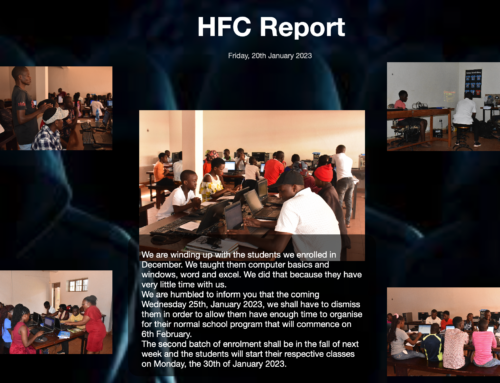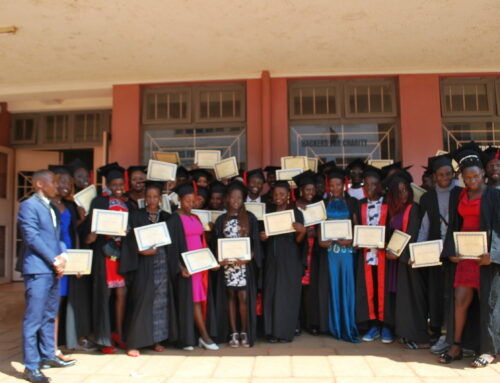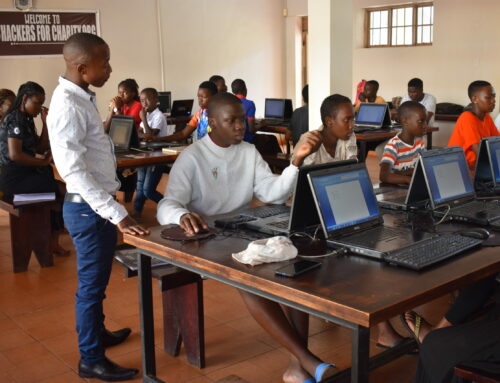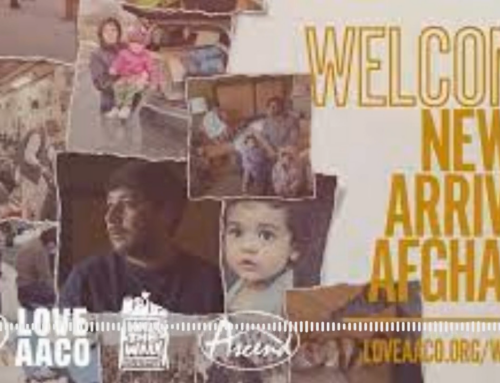Zack Matere crossed my path back in December 2013 with an inquiry to the info@worldpossible.org (“RACHEL“) mailing list. In short, he wanted to get the RACHEL offline education content and some Raspberry Pi’s so he could install them in a local community center which is a “gathering hub” for the people he most wanted to help: “illiterate farmers”.
Did you catch that last bit? This guy wanted to install a Raspberry Pi with educational content in a community center for illiterate farmers. I had to know more. I checked out Zack’s website and found a link to a video. Take two minutes (literally) to watch this video. You won’t be disappointed.
Zack is a potato farmer from rural Soy, Kenya who has become an evangelist for computer-based education. “Excited about the Internet”, he is, “using the Internet to help people”. He’s “searching for a better life for [himself] and [his] neighbors.”
I know, right? Wow!
Zack’s excitement was infectious. Just watching the video got me excited too, and I wanted to help him. But something nagged me.
In 2011, Google came in and produced this amazing video, but here was Zack, three years later, starting a grass-roots effort to get computer-based educational solutions for his community. To me, this meant one of two things: either Zack had gotten pretty tech savvy and had some equipment at his disposal or he was .. starting from scratch. It was hard to tell from his email.
I emailed him and discovered that he was pretty much right where he was three years ago. This was sad, but it made sense. As a potato farmer, he had relatively low income. Internet sessions cost money, and despite his excitement and enthusiasm he didn’t have the luxury of sitting around all day surfing the net and, “growing knowledge” as Google’s film team called it.
That’s why he was hitting up the RACHEL list: he wanted to install local content “all over” because, “When people have the knowledge they can find the solutions without having to be helped out.”
He had also realized that while he couldn’t afford to buy Internet for his neighboring schools and community centers to share his experience, he could create “a better life for him and his neighbors” by installing RACHEL for free “all over”.
He also wanted, “an Internet [his] Grandmother can use”.
But Zack, a farmer, seemed to be hitting way above his technical weight class asking for Raspberry Pi’s, and I didn’t know why.
But a couple of folks, like our friends Robert Holder and “Ed” in the US, jumped on the opportunity to help Zack out. Robert worked on some tracking spreadsheets for school installations and tried to figure out a way to get donors to help Zack out. The latter is still a challenge. Ed hooked Zack up with a couple of Pi’s and a 1TB drive loaded with RACHEL (carried by Ed’s daughter who flew into Nairobi on unrelated business).
It was AMAZING to see geeks with big hearts jumping in to help, but I has some initial fears. The Raspberry Pi would likely be unsupportable by anyone but the most dedicated geek, and in a developing country, parts would be hard to find. I knew that the USB drive would be quickly corrupted by viruses. After the Pi broke and the drive was eaten alive, Zack would be right back where he started. We needed something more resilient.
I called Zack and emailed Robert and Ed and let them know my thoughts, and we decided it was time to visit Zack, talk to him in person and see for ourselves what kind of challenges he was up against. I imagined his challenges would be similar to what we’ve faced in Uganda these past five years, so I packed up some of our solutions to see if they would work for him, but my first priority was to look and listen. So a few days ago, Jen, Declan and I headed to Soy Kenya (by way of Kijabe) to meet Zack.
As an aside, this is very close to the location of our first computer classroom in Webuye Kenya in 2008. Soy is really off the beaten path though, and we found it to be a very small town.
Zack was very gracious to meet us on the main road, despite living quite far away (10km!) from the road. It was pretty cool meeting him in person, and although “movie magic” can do wonders and alter reality, we found Zack to be just like his video persona: he was amicable, spoke very good english, was quite humble, driven and smart. Although we didn’t have much of an agenda, Zack had our time planned out for us. The first stop was the (now) “Washindi” cyber cafe where it all started.
It was pretty cool standing outside the cafe that was shown in the video, and it looked just like the film. However, the inside of the cafe, which wasn’t really shown in the video, was nothing like I imagined it.
The cafe itself was the size of a typical American bedroom. Although they had several computer stations set up, only a few of them were working. Zack showed me around, introduced me to the owner and showed me photos on his very cracked but reasonably modern and usable Android smartphone.
He took the time to show me how he had installed RACHEL only two days before (with Ed’s drive) in a local school. He also installed RACHEL on his brother’s computer (again with Ed’s drive), and Zack was excited about this because his nephew was moving around RACHEL so fast, even “better than he could”.
I took the time to ask Zack what, exactly, he wanted to do, and he told me that he wanted to “move around with RACHEL” and install it “all over”. This was consistent with what he said in the video, and through email conversations. But he had a few challenges.
- He wanted a safe way to install RACHEL. The RACHEL disk he had received from Ed just the week before was now “corrupted a bit” and viruses were eating away his drive and spreading when he installed RACHEL despite the fact that the schools “thought they had good anti-virus”.
- He wanted a device so that many users could share RACHEL even if their computers didn’t have enough “memory” (hard drive space).
- He needed a place to use RACHEL himself, and he needed basic computer training. He didn’t really understand everything RACHEL had to offer since he didn’t have his own install. He was also interested in technology and tried to take some “tech” classes but the teacher expected him to understand “techie stuff” and he really didn’t “understand what any of that was”.
- He wanted to be able to add “local content” to RACHEL, especially if students or farmers had “local knowledge” that they wanted to share.
- He wanted the ability to only install parts of RACHEL at a time.
- Zack needed a way to easily update RACHEL at many schools.
I knew that some of this would be a job for the BRCK (#2, #4, #6 above, more on that soon) but I also knew that we could address many of his needs right now, before the BRCK was ready for deployment. We moved on to one of the schools Zack was interested in helping: Worldgate Academy.
We met with the computer tech and the headmaster at Worldgate and it was there that I began to demonstrate some of the gear we brought. Although I knew Zack’s heart was in the right place, I knew that a demo with someone more tech savvy would help. I began with a demo of the RACHEL-loaded LibraryBox-derived TP-Link MR3040 router.
This device, I explained, was a lightweight less-featured “predecessor” to the BRCK. It would make RACHEL available to multiple computers across wifi and ethernet. I explained that if the USB stick remained in the router (and wasn’t put in a PC), the router couldn’t get viruses, corrupting the content. They were thrilled, but this was a lot of tech for Zach. He did “get it” though and I gave a demo inside the Worldgate computer lab.
Before long, the guys were loading RACHEL on their phones. So far so good!
Next, I gave a demo of the HFC RACHEL “Loaded” Google Chromebook. I knew that technical problems would likely arise with the router (it’s an experiment) but the Loaded Chromebook is the thing I’m super-excited about. We installed a 32gb SD card with RACHEL and GCF loaded on it. We write-locked the SD card, and super-glued the lock meaning it can’t be written to by viruses or anything else. The machine itself is running Chrome so the guest session can’t get viruses, and even if it did, the next guest session would be clean. The Chrome browser is world-class meaning all our browser-based content would run like a champ. To make the software on the SD card even sweeter, we copied it as a slightly modified version of the RACHEL USB installation, meaning that with the SD adapter we included, he could easily copy RACHEL to any machine or drive with USB and have it run as static HTML content or as a MOWES (WAMP) web server serving content to other machines, all without risking a virus (or other) corruption to the SD Card. And obviously, this was a laptop that would allow Zack himself to study RACHEL and even take those tech classes he desperately wanted thanks to the GCF content.
The guys really seemed to love this, even though it was it bit foreign to them (it looks like a standard 11″ laptop) but they really got excited as they asked one question after another. “No viruses? Can we put a monitor on it? Will it surf the Internet? Can we use a USB keyboard and mouse? NO VIRUSES?” (The answer was “Nope, Yes, Yes, Yes, Yes and NOPE!” accordingly).
We said goodbye to Worldgate (after Zack promised to return to install RACHEL and after we took the obligatory photo) and headed to Phanicey Charitable Foundation, the “community center” Zack referred to. The organization was named after Phanicey, a women who taught young people well into her later years. We met Julie, (pictured below) the administrator of the program. She told us that they (among other things) teach kids IT skills, then after they prove they can do the skill they trained on, they go teach it to others. They also set up internships and work on job placement, but always rotate their students through as instructors. Cool.
The program is hosted at the Seregya Primary School, located behind the Phanicey office.
The computer lab was huge (space-wise) and had a lot of working computers. Julie showed us a pile of brand new Dell computers that the student-cum-teachers were prepared to deliver to their new schools. Unfortunately half of them had been obliterated due to a lightning strike. Even in Kenya, in an advanced program like this, there’s still so much to teach, and learn.
The students didn’t have much training software, so they were thrilled to hear about all RACHEL had to offer, and even more excited that they themselves could install the software on the computers before deploying them to schools. This meant that in very short order, Zack’s RACHEL installations would increase exponentially as he passed the package onto the students.
As we left the community center, Zack took us to the St Michael’s Kilimani school, the site of his first RACHEL install with Ed’s 1tb USB disk.
Although we wanted to see more of the school, we had run out of time and we were risking getting back home after dark, so we had to bid Zack farewell for now. I know Zack was a bit overwhelmed with the gear (mostly the router) but he was REALLY excited by the Chromebook and the possibility of installing RACHEL “all over” without fear of viruses.
As we left Soy and headed home, I was proud of what a bunch of geeks were able to accomplish in just under a month’s time by just jumping in where we saw a need. I was a little disappointed that we hadn’t found out about Zack sooner and that he had been itching to do this for so long but all of us (including HFC, WorldPossible, Ed, Robert and others) are excited to see what Zack will do next.
After all, it was Zack himself that put it best: “Information is powerful, but it is how we use it that will define us.”
Amen.






















